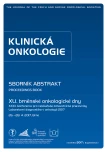Everolimus in Daily Clinical Practice Focusing to Oral Mucosa Damage Issues – Single Oncology Centre Experience within the Course of the Year 2016
Authors:
S. Vokurka; M. Votavová; V. Arnetová; H. Korunková; T. Svoboda; J. Kulhánková; K. Kališová; V. M. Matějka; O. Fiala; J. Fínek
Authors‘ workplace:
Onkologická a radioterapeutická klinika LF UK a FN Plzeň
Published in:
Klin Onkol 2017; 30(Supplementum1): 195-197
Category:
Article
Overview
Background:
Oral mucositis, mTOR associated stomatitis, is a major complication in everolimus (EVE) treatment with an incidence of 44–64%. The management of it in the daily practice has not been described enough, so far.
Patients and Methods:
Retrospective analysis of patients treated with EVE in 2016 at our center, n = 42 patients (69% female), median age 66 (37–81) years, breast cancer in 20 (48%) and renal cell carcinoma in 22 (52%), starting EVE dose of 10 mg/day in 34 (81%) and 5 mg/day in 8 (19%) patients.
Results:
Discomfort and/or dysgeusia without mucosa defects (grade 1 NCI-CTC) was in 4/34 (12%) patients, mucosal defects without oral intake limitation (grade 2) in 6/34 (17.5%), mucosal defects limiting oral intake (grade 3) in 7/34 (20.5%) patients. Actions taken: in grade 1 EVE dose reduced to 5 mg/day in 1/4 affected patients, in grade 2 locally administered dexamethasone solution recommended in 2/6, reduction of EVE to 5 mg/day in 4/6 (in two cases the reduced dose left because of complications recurrences), in grade 3 locally administered dexamehasone solution recommended in 5/7, transient reduction of EVE to 5 mg/day in 1/7, permanent reduction of EVE in 5/7 (recurrent aphthous lesions), EVE terminated in 1/7. In patients with EVE starting dose of 5 mg/day there was one case (1/8, 12.5%) of grade 2 complication requiring no intervention. The complications developed within 2–20 weeks after EVE initiation (median of 8 weeks).
Conclusion:
The incidence of stomatitis and its severity in this cohort is comparable with published trials data, it confirms the significant incidence of damage affecting the quality of life, oral intake and anti-cancer treatment in daily practice. The interventions used in groups of similarly affected patients appears slightly heterogeneous, influenced by individual physician approach. There is tendency not to interrupt the EVE treatment and keep it either in a dosage of 10 or 5 mg/day if the oral damage is tolerable. Local treatment with dexamethasone is not yet fully exploited.
Key words:
everolimus – stomatitis – mucositis – oral cavity
Supported by the grant of Ministry of Health of the Czech Republic – Conceptual Development of Research Organization (Faculty Hospital in Pilsen – FNPl, 00669806) and National Sustainability Program I (NPU I) No. LO1503 provided by the Ministry of Education Youth and Sports of the Czech Republic.
The authors declare they have no potential conflicts of interest concerning drugs, products, or services used in the study.
The Editorial Board declares that the manuscript met the ICMJE recommendation for biomedical papers.
Submitted:
27. 2. 2017
Accepted:
26. 3. 2017
Sources
1. SUKL.cz [internetová stránka]. Státní ústav pro kontrolu léčiv, Česká republika [citováno 20. února 2017]. Dostupné z: http: //www.sukl.cz.
2. Yardley DA, Noguchi S, Pritchard KI et al. Everolimus plus exemestane in postmenopausal patients with HR (+) breast cancer: BOLERO-2 final progression-free survival analysis. Adv Ther 2013; 30 (10): 870–884. doi: 10.1007/s12325-013-0060-1.
3. Motzer RJ, Escudier B, Oudard S et al. Phase 3 trial of everolimus for metastatic renal cell carcinoma: final results and analysis of prognostic factors. Cancer 2010; 116 (18): 4256–4265. doi: 10.1002/cncr.25219.
4. Yao JC, Shah MH, Tetsuhide Ito et al. Everolimus for advanced pancreatic neuroendocrine tumors. N Engl J Med 2011; 364 (6): 514–523. doi: 10.1056/NEJMoa1009290.
5. Pavel ME, Hainsworth JD, Baudin E et al. Everolimus plus octreotide long-acting repeatable for the treatment of advanced neuroendocrine tumours associated with carcinoid syndrome (RADIANT-2): a randomised, placebo-controlled, phase 3 study. Lancet 2011; 378: 2005–2012.
6. Souhrn údajů o přípravku Afinitor tbl, Novartis Europharm Limited [internetová stránka]. Státní ústav pro kontrolu léčiv Česká republika a Evropské léková agentura EMA. [citováno 20. února 2017]. Dostupné z: http: //www.sukl.cz a www.ema.europa.eu.
7. Peterson DE, Boers-Doets CB, Bensadoun RJ et al. Management of oral and gastrointestinal mucosal injury: ESMO Clinical Practice Guidelines for diagnosis, treatment, and follow-up. Ann Oncol 2015; 26 (Suppl 5): v139–v151. doi: 10.1093/annonc/mdv202.
8. Rugo HS, Seneviratne L, Beck JT et al. Prevention of everolimus/ exemestane (EVE/ EXE) stomatitis in postmenopausal (PM) women with hormone receptor-positive (HR+) metastatic breast cancer (MBC) using a dexamethasone-based mouthwash (MW) : results of the SWISH trial. J Clin Oncol 2016; 34 (Suppl) : abstr. 525.
Labels
Paediatric clinical oncology Surgery Clinical oncologyArticle was published in
Clinical Oncology

2017 Issue Supplementum1
- Metamizole vs. Tramadol in Postoperative Analgesia
- Metamizole at a Glance and in Practice – Effective Non-Opioid Analgesic for All Ages
- Possibilities of Using Metamizole in the Treatment of Acute Primary Headaches
- Current Insights into the Antispasmodic and Analgesic Effects of Metamizole on the Gastrointestinal Tract
- Spasmolytic Effect of Metamizole
Most read in this issue
- Ascites May Provide Useful Information for Diagnosis of Ovarian Cancer
- Lactate Dehydrogenase – Old Tumour Marker in the Light of Current Knowledge and Preanalytic Conditions
- Molecular Pathology of Colorectal Cancer, Microsatellite Instability – the Detection, the Relationship to the Pathophysiology and Prognosis
- Circulating Myeloid Suppressor Cells and Their Role in Tumour Immunology
